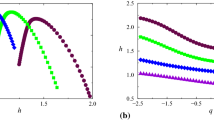The traditional characteristics of long-latency event-related potentials, which are established indictors of higher nervous activity, include the amplitude-time parameters of the components, the topography of power levels, and identification of the locations of equivalent dipole sources. Evaluation of the synchronization of event-related activity is difficult because of the short duration of the process. Wavelet analysis overcomes the disadvantages of traditional Fourier analysis and allows calculation of these characteristics, particularly phase synchronization. The present report is methodological in nature. It proposes an approach to the component analysis of wavelet synchronization of averaged auditory event-related potentials in healthy humans in states with different levels of concentration of attention. The differences seen in the spatial organization of signals seen on listening to sounds and counting them indicate the potential of this methodological approach.
Similar content being viewed by others
References
V. S. Rusinov (ed.), Biopotentials in the Human Brain (mathematical analysis) [in Russian], Meditsina, Moscow (1987).
V. V. Gnezditskii, Evoked Potentials in the Brain in Clinical Practice [in Russian], TRTY, Taganrog (1997).
M. N. Livanov, Spatial Organization of Brain Processes [in Russian], Nauka, Moscow 172
R. I. Machinskaya, “Functional maturation of the brain and the formation of the neurophysiological mechanisms of selective voluntary attention in children of young school age,” Fiziol. Cheloveka, 32, No. 1, 26–36 (2006).
E. L. Masherov, P. E. Volynskii, and G. A. Shchekutiev, “A single approach to removing spatial non-correlating artifacts from the EEG,” Fiziol. Cheloveka,, 35, No. 4, 124–134 (2009).
R. Näätänen, Attention and Brain Function [in Russian], Moscow State University Press, Moscow (1998).
A. R. Nikolaev, G. A. Ivanitskii, and A. M. Ivanitskii, “Studies of cortical interactions over short time intervals during the search for verbal associations,” Zh. Vyssh. Nerv. Deyat., 50, No. 1, 44–61 (2000).
E. V. Sharova, “Electrophysiological correlates of brain reactions to afferent stimuli in post-comatose unconscious states in patients with severe craniocerebral trauma,” Fiziol. Cheloveka, 31, No. 3, 5–15 (2005).
A. B. Shitov, Development of Numerical Methods and Programs Related to the Use of Wavelet Analysis for Modeling and Processing Experimental Data [in Russian], Dissertation in Phys.-Math. Sciences, Ivanovo State University, Ivanovo (2001).
A. R. Nikolaev, P. Gong, and C. Leeuwen, “Evoked phase synchronization between adjacent high-density electrodes in human scalp EEG: Duration and time course related to behavior,” Clin. Neurophysiol., 116, 2403–2419 (2005).
C. J. James and C. W. Hesse, “Independent component analysis for biomedical signals,” Physiol. Meas., 26, No. 1, 15–39 (2005).
J. A. Jiang, C. F. Chao, M. J. Chiu, R. G. Lee, C. L. Tseng, and R. Lin, “An automatic analysis method for detecting and eliminating ECG artefacts in EEG,” Comput. Biol. Med., 37, No. 11, 1660–1671 (2007).
R. Quian Quiroga and H. Garcia, “Single-trial event-related potentials with wavelet denoising,” Clin. Neurophysiol., 114, 376–390 (2003).
P. Senthil Kumar, R. Armuganathan, K. Sivakumar, and C. Vimal, “Removal of ocular artifacts in the EEG through wavelet transform without using an EOG reference channel,” Int. J. Open Problems Compt. Math., 1, No. 3, 188–200 (2008).
G. Stephane, T. Cenier, S. Garcia, P. Litaudon, and N. Buonviso, “A wavelet-based method for local phase extraction from a multifrequency oscillatory signal,” J. Neurosci. Meth., 160, No. 1, 135–143 (2006).
M. Teplan, K. Susmakova, M. Palus, and M. Vejmelka, “Phase synchronization in human EEG during audiovisual stimulation,” Electromagn. Biol. Med., 28, No. 1, 80–84 (2009).
R. Vigário, J. Säräelä, V. Jousmäki, M. Hämäläinen, and E. Oja, “Independent component approach to the analysis of EEG and MEG recordings,” IEEE Trans. Biomed. Eng., 47, No. 5, 589–593 (2000).
Z. Wang, N. K. Logothetis, and H. Liang, “Extraction of perceptrelated induced local field potential during spontaneously reversing perception,” Neural Netw., 22, No. 5–6, 720–727 (2009).
Author information
Authors and Affiliations
Corresponding author
Additional information
Translated from Zhurnal Vysshei Nervnoi Deyatel’nosti imeni I. P. Pavlova, Vol. 61, No. 1, pp. 112–118, January–February, 2011.
Rights and permissions
About this article
Cite this article
Romanov, A.S., Sharova, E.V., Kuznetsova, O.A. et al. Potential of a Wavelet Synchronization Method for Assessing the Long-Latency Components of Auditory Evoked Potentials in Healthy Humans. Neurosci Behav Physi 42, 588–593 (2012). https://doi.org/10.1007/s11055-012-9605-z
Received:
Accepted:
Published:
Issue Date:
DOI: https://doi.org/10.1007/s11055-012-9605-z



